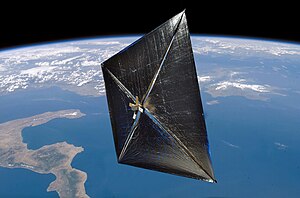
Back NanoSail-D2 Spanish NanoSail D Finnish NanoSail-D2 French NanoSail D Galician NanoSail-D2 Croatian ナノセイルD2 Japanese NanoSail-D2 Latvian/Lettish NanoSail-D2 Polish Nanosail-D2 Swedish NanoSail-D2 Ukrainian
 | |
| Mission type | Technology |
|---|---|
| Operator | NASA |
| COSPAR ID | 2010-070L |
| SATCAT no. | 37361 |
| Mission duration | 240 days |
| Spacecraft properties | |
| Spacecraft type | 3U CubeSat |
| Manufacturer | NASA Ames Research Center NASA Marshall Space Flight Center |
| Launch mass | 4 kg (8.8 lb) |
| Dimensions | 30 cm × 10 cm × 10 cm (11.8 in × 3.9 in × 3.9 in) |
| Power | Batteries |
| Start of mission | |
| Launch date | 20 November 2010, 01:25 UTC |
| Rocket | Minotaur IV / HAPS |
| Launch site | Kodiak Launch Complex, Pad 1 |
| Contractor | Orbital Sciences |
| Deployed from | FASTSAT |
| Deployment date | Commanded: 3 December 2010 Occurred: 17 January 2011 |
| End of mission | |
| Decay date | 17 September 2011 [1] |
| Orbital parameters | |
| Reference system | Geocentric orbit[2] |
| Regime | Low Earth orbit |
| Perigee altitude | 615 km (382 mi) |
| Apogee altitude | 648 km (403 mi) |
| Inclination | 71.97° |
| Period | 97.34 minutes |
NanoSail-D2 was a small satellite built by NASA's Marshall Space Flight Center and Ames Research Center to study the deployment of a solar sail in space. It was a three-unit CubeSat, measuring 30 cm × 10 cm × 10 cm (11.8 in × 3.9 in × 3.9 in) with a mass of 4 kg (8.8 lb).[3] Its solar sail had an area of 10 m2 (110 sq ft),[3] and was deployed in around five seconds.
It was planned to be deployed from the FASTSAT satellite around 3 December 2010, two weeks after launch. The satellite did not eject at that time, but on 17 January 2011, it ejected on its own and deployed its sail three days later on 20 January 2011. The beacon signal began transmitting after ejection and was first received on the afternoon of 19 January 2011.
- ^ "NASA's Nanosail-D 'Sails' Home -- Mission Complete". Archived from the original on 1 December 2011. Retrieved 2 December 2011.
 This article incorporates text from this source, which is in the public domain.
This article incorporates text from this source, which is in the public domain.
- ^ "Satellite Catalog". Jonathan's Space Report. Archived from the original on 25 June 2013. Retrieved 3 May 2018.
- ^ a b "NanoSail D". Gunter's Space Page. Archived from the original on 1 June 2013. Retrieved 20 November 2010.